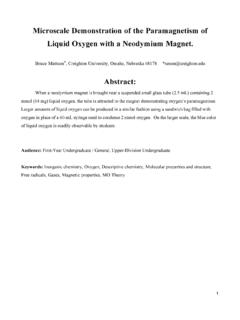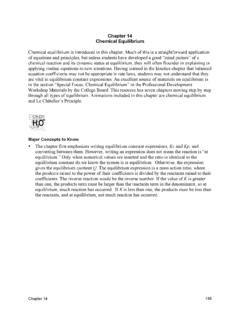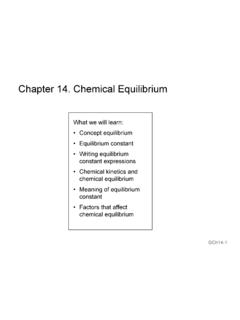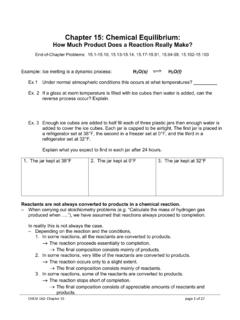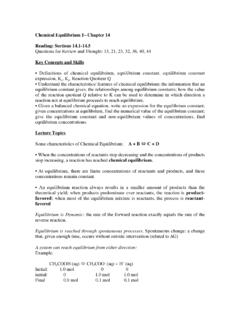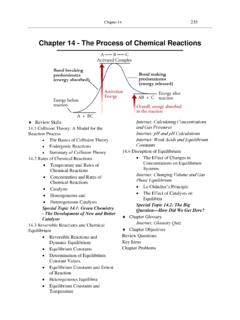Transcription of Guide to Chapter 13. Chemical Equilibrium
1 Dr. Mattson, General Chemistry, Chm 205, Guide to Chapter 13. Chemical Equilibrium1 Guide to Chapter 13. Chemical EquilibriumWe will spend five lecture days on this Chapter . During the first class meeting we will focus on how kineticsmakes a segue into Equilibrium . We will learn how to write Equilibrium constants two different ways, and learnhow to interpret Equilibrium constants. Next we will do some Equilibrium calculations, using equilibriumconcentrations to determine Equilibrium constants and visa versa. You will become adept at setting up andusing ICE tables. We ll discuss mass action expressions that let us understand what needs to happen inorder to get to Equilibrium . We will spend time with LeCh telier s principle end the Chapter the way we started:tying kinetics and Equilibrium together. Read the introductory paragraph to Chapter 13. Read Section The Equilibrium State. Learning Objective 1: Know how reaction situations described by kinetics eventually segue intoequilibrium situations Do the following end-of- Chapter problem: 28 Problem Club Question A (ACS Style): Which is true, by definition, for a system that has reached a state ofchemical Equilibrium ?
2 (A)The substance having the smaller volume has a tendency to form at the expense of the othersubstances.(B)No further reaction occurs in either direction.(C)The concentrations of reactants and products are necessarily equal.(D)The opposing reactions have equal velocities.(E)The total mass of the products is equal to the total mass of the : D Read Sections : Section The Equilibrium constant, Kc; Section Theequilibrium constant, Kp; and Section Heterogeneous equilibria. Learning Objective 2: Be able to write the Equilibrium expressions, Kc, for a given balanced chemicalreaction involving homogeneous Equilibrium . Learning Objective 3: Be able to write the Equilibrium expressions, Kc, for a given balanced chemicalreactions involving heterogeneous Equilibrium Learning Objective 4: Be able to write the Equilibrium expressions, Kp, for a given balanced chemicalreaction involving homogeneous Equilibrium . Learning Objective 5: Be able to write the Equilibrium expressions, Kp, for a given balanced chemicalreactions involving heterogeneous Equilibrium Learning Objective 6: Using given concentrations of reactant(s) and product(s), determine the numericalvalue of the Equilibrium constant Kc or Kp for a reaction.
3 Learning Objective 7: Know the significance of very large (or small) Equilibrium constants. Learning Objective 8: Be able to determine the Equilibrium constant expression and the equilibriumconstant for situations where Chemical equations are reversed, multiplied through by constantcoefficients, or added together. Learning Objective 9: Given Kc, calculate Kp or vice versa. Do Problems 1 - 4 at the end of Section , Problems 5 and 6 at the end of Section and Problem 7 atthe end of section Mattson, General Chemistry, Chm 205, Guide to Chapter 13. Chemical Equilibrium2 Do the following end-of- Chapter problems: 30, 38, 40, 42, 44, 46, 48, 50, 52, 54, 56, 58 Problem Club Question B. Write Kc expressions for (a) SnO2(s) + 2 H2(g) Sn(s) + 2 H2O(g) (b) PCl5(s) + H2O(l) 2 HCl(g)+ POCl3(g) (c)CO(g) + 2 H2(g) CH3OH(g)Answer: a. Kc = [H2O]2/[H2]2b. Kc = [HCl]2[POCl3]c. Kc = [CH3OH]/[H2]2[CO] Problem Club Question C. When COCl2 is heated to 527 oC in a reaction vessel, the following equilibriumis attained:COCl2(g) CO(g) + Cl2(g)If the Equilibrium concentrations are found to be [CO] = , [Cl2] = and [COCl2] = M,what is the Equilibrium constant?
4 Answer: Problem Club Question D. Consider the reaction:H2(g) + Cl2(g) 2 HCl(g) Kc = x 104 Write the Equilibrium expressions, Kc =, and determine Kc for each of the following: (a)1/2 H2(g) + 1/2 Cl2(g) HCl(g) (b) 2 HCl(g) H2(g)+ Cl2(g) (c) HCl(g) 1/2 H2(g) + 1/2 Cl2(g)Answer: a. 130b. x 10-5c. Problem Club Question E. Consider the following equilibria at 127 oC. Calculate Kp for this NH3(g) N2(g) + 3 H2(g)Kc = x 10-5 Answer: Problem Club Question F (ACS Style): Answer: D Problem Club Question G (ACS Style): Answer: E Read Sections Using the Equilibrium constant. Learning Objective 10: Use the reaction quotient (Q) to determine if a reaction mixture is atequilibrium. Predict the direction a reaction will shift by comparing the reaction quotient (Q) with Kcor Kp. Learning Objective 11: Given sufficient data concerning initial or Equilibrium concentrations ofreactants and/or products determine the Equilibrium concentrations of each substance in the balancedreaction and the value of Kc.
5 Learning Objective 12: Given sufficient data concerning initial or Equilibrium partial pressures ofgaseous reactants and/or products determine the Equilibrium partial pressures of each substance in thebalanced reaction and the value of KpDr. Mattson, General Chemistry, Chm 205, Guide to Chapter 13. Chemical Equilibrium3 Learning Objective 13: Given the Equilibrium constant, Kc, and information concerning theconcentration (initial or Equilibrium ) of reactants/products, calculate the Equilibrium concentration ofeach species in a balanced Equilibrium reaction. Do Problems 8 - 15 embedded within this big section. Do the following end-of- Chapter problems: 60, 62, 64, 66, 68, 70, 72, 74, 76, 94, 96, 98, 100, 106 Problem Club Question H. Consider the reaction below along with the Equilibrium constant (g) 2 NO2(g)Kc = that [N2O4] = M at Equilibrium . Calculate the concentration of NO2 at in most of these problems, begin by writing the Equilibrium expression, : Problem Club Question I.
6 Consider the Equilibrium :.N2(g) + O2(g) 2 NO(g)Kc = at 2200oCIf moles of NO were placed in a L flask and allowed to reach Equilibrium , what is theequilibrium concentration of each gas? Hint: Make an ICE : [N2] = [O2] = [NO] = Problem Club Question J. Consider the Equilibrium :H2(g) + I2(g) 2 HI(g) Kc = , iodine and HI were placed in a flask in order that the initial concentrations were [H2] = 2 M,[I2] = 4 M, and [HI] = M. Determine if the system is at Equilibrium . If not, which direction must itshift in order to attain Equilibrium ? Start with the Qc : Qc = so reaction must shift right. Problem Club Question K. For which value for K will the Equilibrium mixture consist almost entirely ofreactants?A. 1 x 10-12B. 19E. 3 x 107 Answer: A Problem Club Question L. Consider the reaction:PCl5(g) PCl3(g) + Cl2(g)Kc = at 250oCA mol sample of PCl5 is injected into a reaction vessel. Calculate the concentration of eachgas at : [PCl5] = M; [PCl3] = M; [Cl2] = M Problem Club Question M.
7 For the all-gas system: 2 X + Y 3 ZK = Starting with M concentrations of X and Y, it was found that the Equilibrium concentration of Xwas M. What is [Z] at Equilibrium ?Answer: Problem Club Question N. Suppose mol NO were placed in a flask at 2273 K. At Equilibrium , mol N2 and mol O2 are present. What is Kc for the reaction at this temperature?N2(g) + O2(g) 2 NO(g)Dr. Mattson, General Chemistry, Chm 205, Guide to Chapter 13. Chemical Equilibrium4 Answer: Problem Club Question O. At 70oC, Kc = for the Equilibrium given below. If at Equilibrium , N2O4 = M, what is the molar concentration of NO2?N2O4(g) 2NO2(g) Problem Club Question P. The value of Kc for the equilibriumPCl5(g) PCl3(g) + Cl2(g)is at 250oC. If mol PCl3 mol Cl2 and mol PCl5 were mixed in a L container,which direction, if either, will the reaction shift in order to establish Equilibrium ?Answer: shift right Problem Club Question Q (ACS Style): Answer: C Problem Club Question R (ACS Style): Answer: D Problem Club Question S (ACS Style): Answer: B Problem Club Question T (ACS Style): Answer: C Problem Club Question U (ACS Style): Answer: D Problem Club Question V (ACS Style): Answer: B Read Sections Factors that alter the composition of an Equilibrium mixture andSection Altering an Equilibrium mixture: Changes in concentration Learning Objective 14: Use Le Ch telier's Principle to qualitatively predict the direction theequilibrium will shift (right or left) when a change in concentration has been introduced.
8 Do Problem 16 at the end of this section. Do the following end-of- Chapter problem: 78 Problem Club Question W. Consider the Equilibrium : H2(g) + CO2(g) H2O(g) + CO(g)Predict the qualitative effect on the Equilibrium concentration of each gas by an increase in the pressureof : H2 and CO2 increases; CO decreases Read Sections Altering an Equilibrium mixture: Changes in pressure and volume Learning Objective 14: Use Le Ch telier's Principle to qualitatively predict the direction theequilibrium will shift (right or left) when a change in pressure has been introduced. Learning Objective 14: Use Le Ch telier's Principle to qualitatively predict the direction theequilibrium will shift (right or left) when a change in volume has been introduced. Do Problems 17 and 18 at the end of this section. Do the following end-of- Chapter problems: 80 Problem Club Question X. For the system A(g) B(g) + 2 C(g), the Kc is x 1016. Which of thefollowing statements is possible?Dr. Mattson, General Chemistry, Chm 205, Guide to Chapter 13.
9 Chemical Equilibrium5A. The Equilibrium [B] and [C] is much greater than [A].B. Increasing the pressure will decrease Adding A will increase KcD. Increasing the volume container will increase KcAnswer: A Problem Club Question Y. Which of the following would shift left if the container volume were decreased?Shift right? Not shift? (a) N2(g) + O2(g) 2 NO(g)(b) 2 NO(g) + O2(g) 2 NO2(g)(c) 2 HI(g) H2(g) + I2(g)(d) 2 HI(g) H2(g) + I2(s)Answer: a. no shiftb. shift rightc. no shift Problem Club Question Z. For which of the equilibria in the previous question is Kc = Kp?Answer: a and c Problem Club Question AA (ACS Style): Answer: D Read Sections Altering an Equilibrium mixture: Changes in temperature. Learning Objective 14: Use Le Ch telier's Principle to qualitatively predict the direction theequilibrium will shift (right or left) when a change in temperature has been introduced. Learning Objective 26: Qualitatively predict how Kc or Kp will change (increase or decrease ) when thetemperature is changed.
10 Do Problems 19 - 21 at the end of this section. Do the following end-of- Chapter problems: 34, 36, 82 Problem Club Question BB. Consider the reaction:C(s) + 2 H2(g) CH4(g)DH = -75 kJ:Which way will the Equilibrium shift by: (a) an increase in temperature (b) an increase in the size of the reaction container's volume (c) an increase in the pressure of hydrogen (d) a decrease in the pressure of methane (e) addition of more carbonAnswer: a. L b. L c. R d. R d. righte. no effect Problem Club Question CC. Consider the Equilibrium :2 NH3(g) N2(g) + 3 H2(g)DH = -92 kJThe concentration of NH3 may be increased by: (possibly more than one of the following!)A. increasing the pressure in the decreasing the pressure in the containerC. adding an inert gas such as argonD. increasing the temperatureE. adding hydrogenAnswer: a. Y b. N c. N d. Y e. Y Problem Club Question DD. (ACS-Style) Answer: CDr. Mattson, General Chemistry, Chm 205, Guide to Chapter 13. Chemical Equilibrium6 Problem Club Question EE (ACS Style): Answer: A Problem Club Question FF (ACS Style): Answer: C Read Sections The effect of a catalyst on Equilibrium .

